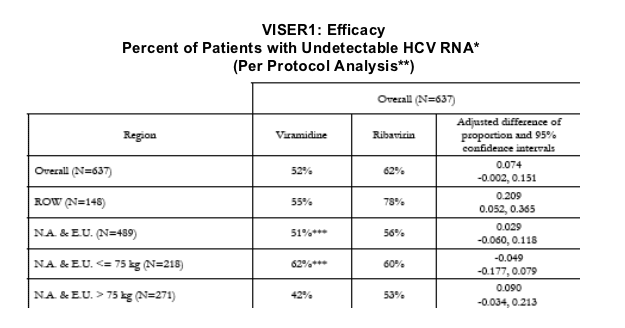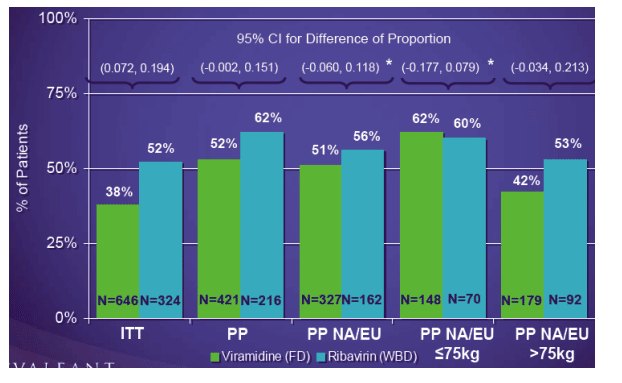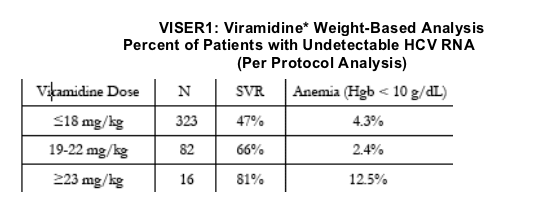| |
Valeant Releases Viramidine Data - Falls Short of Efficacy Goal
|
| |
| |
Following several newswire reports regarding Valeant's release of new study data that questions the efficscy of Viramidine is the press release from Valeant containing tables & graphs of the data.
Valeant falls on failed efficacy goal
Reuters/Associated Press/Business Week. MAR. 21 9:06 A.M. ET Shares of Valeant Pharmaceuticals International dropped Tuesday after the drug maker said that overall response rates for its hepatitis C treatment in a late stage clinical study were lower than expected even though safety rates were better than standard treatment.
Valeant shares fell $3.03, or 16.2 percent, to $15.65 in premarket activity.
The company said that Viramidine fell short of one of its primary endpoints and was inferior to ribavirin on an intent-to-treat basis. "Intent-to-treat" means that if a patient who was randomized to receive ribavirin was given Viramidine instead at the discretion of the doctor, the patient is analyzed as if they had been given the intended treatment, or in this case, ribavirin.
Valeant tested its drug Viramidine for use in combination with pegylated interferon for patients with chronic hepatitis C who had never been treated.
Ribavirin and pegylated interferon are standard therapy for hepatitis C, but they are associated with side effects. Valeant had hoped to prove its therapy was safer than standard treatment, but just as effective.
Valeant said results were hurt by the effect of lower dosing and other statistically inconsistent results. It said patients on a higher dose of the drug had a better response.
The company is conducting a second late-stage trial and said it will continue to work toward commercial launch of the product before the end of 2007.
On this basis, Viramidine achieved a sustained viral response in 38 percent of patients compared with 52 percent in the ribavirin group. However, the company said that Viramidine response rates were hurt by low dosing rates with respect to body weight and statistically inconsistent results outside of North America and Europe.
The company said results from North America and Europe showed a sustained viral response in 51 percent of patients compared with 56 percent for ribavirin. In these regions, for patients weighing less than 165 pounds, 62 percent of patients given Viramidine showed a sustained viral response compared with 60 percent of ribavirin patients.
Viramidine achieved its other primary endpoint of superior safety to ribavirin. The study showed that 5 percent of patients given Viramidine showed signs of anemia compared to 24 percent of patients treated with ribavirin.
The company plans to try to get Viramidine on the market by the end of 2007.
Valeant Pharmaceuticals Reports VISER1 Results for Viramidine(R); Superior Safety Confirmed; Analysis Indicates Efficacy Linked to Weight-based Dosing of Viramidine
finanzen.net
21.03.2006 13:00:00
Valeant Pharmaceuticals International (NYSE:VRX) todayreported summary results of VISER1, the first of two Phase 3 pivotaltrials, for Viramidine(R). The company is developing Viramidine(taribavirin hydrochloride), a nucleoside (guanosine) analog prodrugof ribavirin, in oral form, for administration in combination with apegylated interferon for the treatment of chronic hepatitis C intreatment-naive patients. The VISER1 trial included two co-primaryendpoints: one for safety (superiority to ribavirin in the incidenceof anemia) and one for efficacy (non-inferiority to ribavirin insustained viral response, SVR).
The VISER1 results confirmed the superior safety profile ofViramidine. Anemia rates (Hgb less than 10g/dL) during the treatmentperiod were statistically significantly lower in patients treated withViramidine than those treated with ribavirin (5 percent versus 24percent; p less than 0.0001).
The VISER1 study did not meet the non-inferiority efficacyendpoint on an overall intent-to-treat (ITT) basis; however, the SVRrates were adversely impacted by the effect of lower dosing on a mg/kgbasis in the Viramidine arm and by statistically inconsistent resultsseen in the rest of world (ROW) region. The overall ITT SVR rate forViramidine was 38 percent versus 52 percent for ribavirin. On a perprotocol basis, the SVR rates for Viramidine in North America andEurope combined were 51 percent versus 56 percent for ribavirin. Inthese same regions, the SVR rates for patients weighing less than orequal to 75 kilograms were 62 percent for Viramidine versus 60 percentfor ribavirin. In both of these analyses, the Viramidine SVR rates metthe non-inferiority criteria.
Timothy C. Tyson, Valeant's president and chief executive officer,said, "The first Viramidine Phase 3 study continues to demonstratethat Viramidine results in a significant reduction in anemia comparedto ribavirin. I am also excited that the weight-based analysisindicates higher Viramidine dosing is associated with higher efficacywithout losing the superior safety profile with respect to anemia. Wecontinue to work toward commercial launch of Viramidine before the endof 2007."
Per protocol analyses in the following table highlights the impactof body weight and the ROW anomaly on SVR rates.
VALEANT PHARMACEUTICALS REPORTS VISER1 RESULTS FOR VIRAMIDINE
Press announcement today distributed by Valeant.
-- Superior Safety Confirmed --
-- Analysis Indicates Efficacy Linked to Weight-based Dosing of Viramidine --
COSTA MESA, Calif., March 21, 2006 - Valeant Pharmaceuticals International (NYSE: VRX) today reported summary results of VISER1, the first of two Phase 3 pivotal trials, for Viramidine . The company is developing Viramidine (taribavirin hydrochloride), a nucleoside (guanosine) analog prodrug of ribavirin, in oral form, for administration in combination with a pegylated interferon for the treatment of chronic hepatitis C in treatment-naive patients. The VISER1 trial included two co-primary endpoints: one for safety (superiority to ribavirin in the incidence of anemia) and one for efficacy (non-inferiority to ribavirin in sustained viral response, SVR).
The VISER1 results confirmed the superior safety profile of Viramidine. Anemia rates (Hgb < 10g/dL) during the treatment period were statistically significantly lower in patients treated with Viramidine than those treated with ribavirin (5 percent versus 24 percent; p<0.0001).
The VISER1 study did not meet the non-inferiority efficacy endpoint on an overall intent-to-treat (ITT) basis; however, the SVR rates were adversely impacted by the effect of lower dosing on a mg/kg basis in the Viramidine arm and by statistically inconsistent results seen in the rest of world (ROW) region. The overall ITT SVR rate for Viramidine was 38 percent versus 52 percent for ribavirin. On a per protocol basis, the SVR rates for Viramidine in North America and Europe combined were 51 percent versus 56 percent for ribavirin. In these same regions, the SVR rates for patients weighing less than or equal to 75 kilograms were 62 percent for Viramidine versus 60 percent for ribavirin. In both of these analyses, the Viramidine SVR rates met the non-inferiority criteria.
Timothy C. Tyson, Valeant's president and chief executive officer, said, "The first Viramidine Phase 3 study continues to demonstrate that Viramidine results in a significant reduction in anemia compared to ribavirin. I am also excited that the weight-based analysis indicates higher Viramidine dosing is associated with higher efficacy without losing the superior safety profile with respect to anemia. We continue to work toward commercial launch of Viramidine before the end of 2007. "

another easier to read version of the table immediately above-
Viramidine Efficacy AnalysisSustained Virologic ResponseViramidine Efficacy AnalysisSustained Virologic Response (*Meets non-inferiority criteria)

NGI SuperQuant Assay, sensitivity to 39 IU/mL (100 copies/mL)
** Defined as patients receiving 90% of peginterferon doses, 90% of ribavirin or Viramidine doses and completing the intended treatment duration. Excludes protocol violations. The per protocol analyses were defined before the study was unblinded in the Statistical Analysis Plan in agreement with the FDA.
*** Met non-inferiority criteria as compared to ribavirin.
Kim D. Lamon, M.D., Ph.D., Valeant's president, research and development, and chief scientific officer, noted, "The VISER1 trial provided sufficient data to show that Viramidine demonstrates meaningful clinical efficacy and superior safety and allows patients to complete optimal therapy by minimizing the chance of experiencing dose reductions or discontinuations as the result of the toxicity of anemia. Other analyses of the trial data clearly demonstrate that increasing mg/kg concentrations of Viramidine improve the response rate without a proportionate increase in the incidence of anemia. In addition, the inconsistencies coming from ROW sites, which represented approximately 20 percent of the entire population, are an anomaly that confounds the overall results. Reviews of all investigative sites in these countries are underway. Other adverse events did not appreciably increase with higher doses of Viramidine."
Additional planned analyses of the data based on weight (mg/kg) indicated that SVR was improved with increased mg/kg concentrations while preserving the safety benefit as summarized below:

*Fixed dose of Viramidine averaged approximately 15 mg/kg, based on mean weight for the study population.
Adverse events other than anemia were similar between treatment groups. The most common other adverse events associated with combination therapy included fatigue, headache, insomnia, depression and myalgia.
VISER1 Trial Design
The VISER1 trial (VISER stands for VIramidine's Safety and Efficacy vs. Ribavirin) evaluated a fixed 600 mg BID dose of Viramidine to a weight-based 1,000/1,200 mg daily dose of ribavirin, both in combination with peginterferon alfa 2b. The study, conducted in the United States, Canada, Europe, Israel, New Zealand and Australia, enrolled 970 treatment-naive subjects with chronic HCV. Treatment duration was based on genotype, with genotypes 2 and 3 receiving 24 weeks of treatment and genotype non 2, 3 receiving 48 weeks of treatment, each with a post-treatment follow-up period of 24 weeks. The study was stratified for genotype, weight and viral load.
Additional information regarding the Phase 3 trial was furnished by the company today with the Securities and Exchange Commission on Form 8-K and is also available on the company's Web site at www.valeant.com.
Conference Call and Webcast Information:
Valeant will host a conference call today at 8:30 a.m. EST (5:30 a.m. PST) to discuss the VISER1 data results. The dial-in number to participate on this call is (877) 295-5743, confirmation code 6907744. International callers should dial (706) 679-0845, confirmation code 6907744. The company will also webcast the conference call live over the Internet. The webcast may be accessed through the investor relations section of Valeant's corporate Web site at www.valeant.com..
Viramidine is an investigational compound that has not been found by the Food and Drug Administration (FDA) or any other regulatory agency to be safe or effective in the diagnosis, mitigation, treatment or cure of any disease or illness. It may not be sold or promoted in the United States unless and until FDA has approved a New Drug Application. Similar restrictions apply in other countries.
About Valeant
Valeant Pharmaceuticals International (NYSE: VRX) is a global, research-based specialty pharmaceutical company that discovers, develops, manufactures and markets a broad range of pharmaceutical products. More information about Valeant can be found at www.valeant.com.
Viramidine is a registered trademark of Valeant Pharmaceuticals International or its related companies. All other trademarks are the trademarks or the registered trademarks of their respective owners.
FORWARD-LOOKING STATEMENTS
This press release contains forward-looking statements within the meaning of the federal securities laws relating to expectations, plans or prospects for Valeant Pharmaceuticals, including funding and conducting clinical trials and expected research and development expenses. These statements are based upon the current expectations and beliefs of Valeant Pharmaceuticals' management and are subject to certain risks and uncertainties that could cause actual results to differ materially from those described in the forward-looking statements. These risks and uncertainties include market conditions and other factors beyond Valeant Pharmaceuticals' control, adverse events that would require the clinical trials to be prematurely terminated, clinical results that indicate continuing clinical and commercial pursuit of Viramidine is not advisable, and the risk factors and other cautionary statements discussed in Valeant Pharmaceuticals' filings with the U.S. Securities and Exchange Commission.
|
|
| |
| |
|
|
|